C++实战项目:日期计算器的实现
近听水无声477 2024-08-22 10:35:02 阅读 95
前言
Hello,小伙伴们,经过了前面对C++基础知识的学习,我们今天就着重运用一下前面学习到的知识,来通过类和对象以及运算符重载的部分知识来实现,来完成我们的日期计算器。
日期计算器,顾名思义,就是可以通过日期和天数来进行年、月、日的转换、计算。
1.可以实现具体日期与天数的加减,并得到加减计算后的日期。
2.可以实现两个具体日期之间的加减,计算两日期之间相差的天数。

功能不是特别的复杂,我们现在就可以着手尝试了。
好,按例三连上车不迷路,开始我们今天的内容。
在看这篇文章的时候,强烈推荐大家先看看我之前的这两篇文章,来学习一下C++类和对象的基础:
http://t.csdnimg.cn/OY9mJ
http://t.csdnimg.cn/ZK1sA
1.日期类的定义
首先我们要定义一个日期类,运用我们刚学习的C++知识,我们这里直接看代码:
案例,我们还是先创建3个文件来实现我们的目的

<code>#pragma once
#include<iostream>
#include<assert.h>
class Date
{
public:
Date(int year = 2024, int month = 8, int day = 16);
//~Date();
private:
int _year;
int _month;
int _day;
};
在这里,我们先来解决构造函数和析构函数的问题:
构造函数:
我们在Date.cpp文件中实现他的功能:
Date::Date(int year, int month, int day)
{
_year = year;
_month = month;
_day = day;
}
由于在日期类中,我们没有申请内存空间,也就是该类中不存在深度拷贝,因此我们就不需要自己单独实现析构函数。
2.日期类的打印(DatePrint)
完成构造函数后,我们就可以通过打印函数来显示我们定义的日期类的值:
首先我们要完成日期打印函数的声明:
#pragma once
#include<iostream>
#include<assert.h>
class Date
{
public:
Date(int year = 2024, int month = 8, int day = 16);
//~Date();
void DatePeint();//日期打印
private:
int _year;
int _month;
int _day;
};
接下来我们来实现日期类打印函数的功能:
void Date::DatePrint()
{
cout << _year << "/" << _month << "/" << _day << endl;
}
接下来我们来展示一下这个函数的功能:
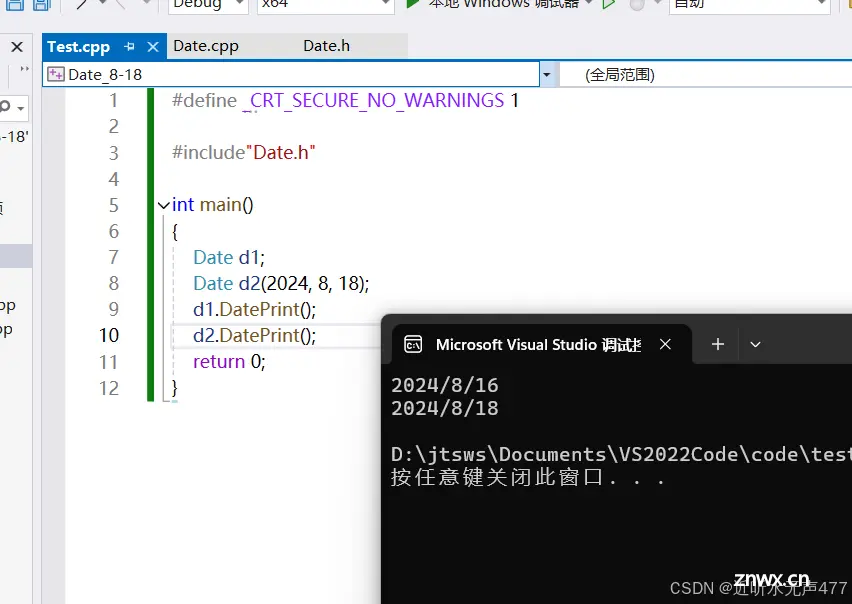
3.比较运算符的重载
前面我们学习了运算符重载方面的知识,我们接下来就设计及应用一下:
比较运算符的种类有很多,但是在运算符重载上实现的方法基本一样,这里借用我们前面学到的知识很容易就能实现:
<code>#pragma once
#include<iostream>
#include<assert.h>
class Date
{
public:
Date(int year = 2024, int month = 8, int day = 16);
//~Date();
void DatePeint();//日期打印
//比较大小运算符的重载
bool operator==(Date& d);
bool operator!=(Date& d);
bool operator>(Date& d);
bool operator<(Date& d);
bool operator<=(Date& d);
bool operator>=(Date& d);
private:
int _year;
int _month;
int _day;
};
代码实现:
bool Date::operator==(Date& d)
{
return _year == d._day
&& _month == d._month
&& _day == d._day;
}
Date& Date::operator=(const Date& d1)
{
_year = d1._year;
_month = d1._month;
_day = d1._day;
return *this;
}
bool Date::operator!=(Date& d)
{
return !(*this == d);
}
bool Date::operator>(Date& d)
{
if (_year > d._year )
{
return true;
}
else if (_year == d._year && _month >d._month)
{
return true;
}
else if (_year == d._year && _month == d._month && _day > d._day)
{
return true;
}
return false;
}
bool Date::operator<(Date& d)
{
return !(*this >= d);
}
bool Date::operator<=(Date& d)
{
return *this < d || *this == d;
}
bool Date::operator>=(Date& d)
{
return *this > d || *this == d;
}
运算符重载的实现逻辑十分的灵活,我们只需要实现几种基本的运算符重载,其他的我们就能够根据已知的运算关系,并运用或且非的逻辑关系来实现其余的运算符重载。
4.日期+= 和 +操作(日期加天数)的实现
首先我们还是先来定义这个运算符的重载:
要实现日期与天数的加操作,我们就好要得到每个月的天数:
#pragma once
#include<iostream>
#include<assert.h>
class Date
{
public:
Date(int year = 2024, int month = 8, int day = 16);
//~Date();
void DatePeint();//日期打印
//比较大小运算符的重载
bool operator==(Date& d);
bool operator!=(Date& d);
bool operator>(Date& d);
bool operator<(Date& d);
bool operator<=(Date& d);
bool operator>=(Date& d);
//获取每个月的天数
int GetMonthDay(int year, int month)
{
assert(month >= 1 && month <= 12);
//因为这个数组会高频·的进行调用,所以使用静态数组就能极大地提高效率
static int MonthDay[13] = { -1, 31,28, 31 ,30, 31,30, 31, 31, 30, 31, 30, 31 };
//借用短路效应,适当的提高效率
if ( month == 2 && (year % 4 == 0 && year % 100 != 0) || year % 400 == 0)
{
return 29;
}
return MonthDay[month];
}
Date& operator+=(int day);//日期与天数的加运算
Date operator+(int day);
private:
int _year;
int _month;
int _day;
};
实现的逻辑也十分的简单,我们先来看看代码:
Date& Date::operator+=(int day)
{
if (day < 0)
{
return (*this -= -day);
}
_day += day;
while (_day > GetMonthDay(_year, _month))
{
_day -= GetMonthDay(_year, _month);
_month++;
if (_month >= 13)
{
_year++;
_month = 1;
}
}
return *this;
}
Date Date::operator+(int day)
{
Date tmp = *this;
tmp += day;
return tmp;
}
接下来我们来看看效果
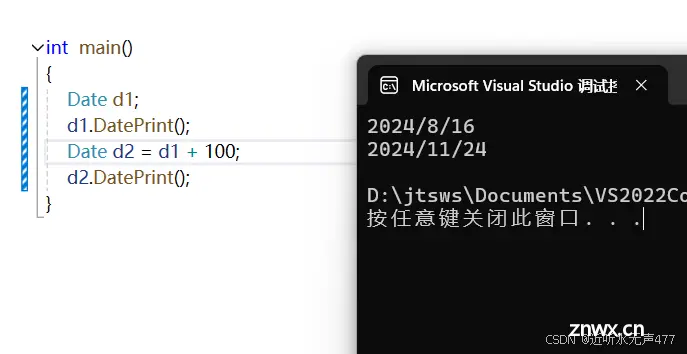
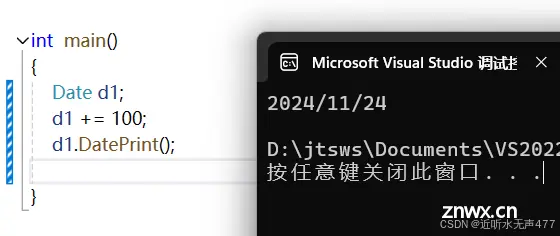
接下来,我们使用网上的日期运算器来验证一下答案是否正确:

5.日期-=和 -操作(日期减天数)的实现
日期与天数的想减得到日期的算法和前面的相加算法也相似。
我们还是先来定义相减运算:
<code>#pragma once
#include<iostream>
#include<assert.h>
class Date
{
public:
Date(int year = 2024, int month = 8, int day = 16);
//~Date();
void DatePeint();//日期打印
//比较大小运算符的重载
bool operator==(Date& d);
bool operator!=(Date& d);
bool operator>(Date& d);
bool operator<(Date& d);
bool operator<=(Date& d);
bool operator>=(Date& d);
//获取每个月的天数
int GetMonthDay(int year, int month)
{
assert(month >= 1 && month <= 12);
//因为这个数组会高频·的进行调用,所以使用静态数组就能极大地提高效率
static int MonthDay[13] = { -1, 31,28, 31 ,30, 31,30, 31, 31, 30, 31, 30, 31 };
//借用短路效应,适当的提高效率
if ( month == 2 && (year % 4 == 0 && year % 100 != 0) || year % 400 == 0)
{
return 29;
}
return MonthDay[month];
}
Date& operator+=(int day);//日期与天数的加运算
Date operator+(int day);
Date& operator+=(int day);//日期与天数的减运算
Date operator+(int day);
private:
int _year;
int _month;
int _day;
};
减运算符重载的实现与加运算符的实现逻辑基本相同,我们直接看代码:
Date& Date::operator-=(int day)
{
if (day < 0)
{
return (*this += -day);
}
_day -= day;
while (_day <= 0)
{
_day += GetMonthDay(_year, _month);
_month--;
while (_month <= 0)
{
_year--;
_month = 12;
}
}
return *this;
}
Date Date::operator-(int day)
{
Date tmp = *this;
tmp -= day;
return tmp;
}
接下来我们来测试一下运行效果:
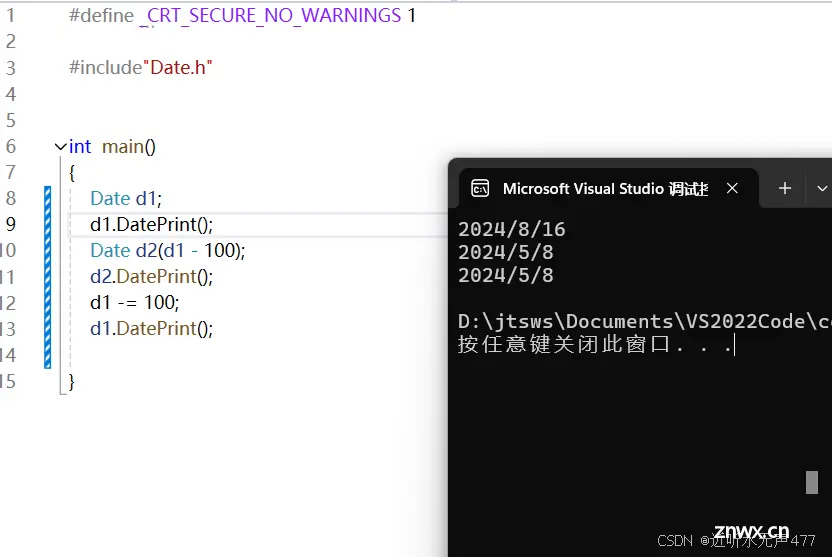
让我们用日期计算器来验算一下日期的计算结果是否正确:
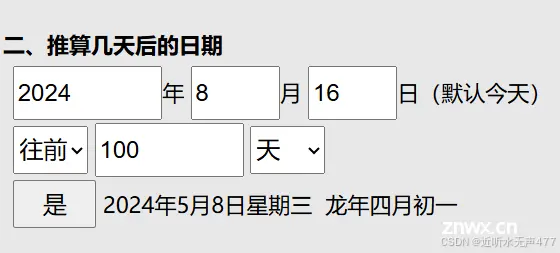
6. 前置++(--)与后置++(--)
根据我们前面的基础知识,我们知道前置++(--)和后置++(--)的冲在式定义就是根据是否有参数来判断的,所以本质上他们的实现就与+=(-=)和-=(-) 相似。
首先来看定义:
<code>#pragma once
#include<iostream>
#include<assert.h>
class Date
{
public:
Date(int year = 2024, int month = 8, int day = 16);
//~Date();
void DatePeint();//日期打印
//比较大小运算符的重载
bool operator==(Date& d);
bool operator!=(Date& d);
bool operator>(Date& d);
bool operator<(Date& d);
bool operator<=(Date& d);
bool operator>=(Date& d);
//获取每个月的天数
int GetMonthDay(int year, int month)
{
assert(month >= 1 && month <= 12);
//因为这个数组会高频·的进行调用,所以使用静态数组就能极大地提高效率
static int MonthDay[13] = { -1, 31,28, 31 ,30, 31,30, 31, 31, 30, 31, 30, 31 };
//借用短路效应,适当的提高效率
if ( month == 2 && (year % 4 == 0 && year % 100 != 0) || year % 400 == 0)
{
return 29;
}
return MonthDay[month];
}
Date& operator+=(int day);//日期与天数的加运算
Date operator+(int day);
Date& operator-=(int day);//日期与天数的减运算
Date operator-(int day);
//前置和后置的区别就是看式子中是不是有参数
Date& operator++();
Date& operator++(int );
Date& operator--();
Date& operator--(int);
private:
int _year;
int _month;
int _day;
};
我们直接来代码:
Date& Date::operator++()
{
return (*this += 1);
}
Date& Date::operator++(int)
{
Date tmp(*this);
*this += 1;
return tmp;
}
Date& Date:: operator--()
{
return (*this -= 1);
}
Date& Date::operator--(int)
{
Date tmp(*this);
*this -= 1;
return tmp;
}
简单的来看看效果,单独看这个的用处好像是不大,但是结合到接下来我们要实现的功能,这个重载式就会发挥很大的作用:
7.两日期之间相差的天数
首先我们还是先来定义这个重载式:
#pragma once
#include<iostream>
#include<assert.h>
class Date
{
public:
Date(int year = 2024, int month = 8, int day = 16);
//~Date();
void DatePeint();//日期打印
//比较大小运算符的重载
bool operator==(Date& d);
bool operator!=(Date& d);
bool operator>(Date& d);
bool operator<(Date& d);
bool operator<=(Date& d);
bool operator>=(Date& d);
//获取每个月的天数
int GetMonthDay(int year, int month)
{
assert(month >= 1 && month <= 12);
//因为这个数组会高频·的进行调用,所以使用静态数组就能极大地提高效率
static int MonthDay[13] = { -1, 31,28, 31 ,30, 31,30, 31, 31, 30, 31, 30, 31 };
//借用短路效应,适当的提高效率
if ( month == 2 && (year % 4 == 0 && year % 100 != 0) || year % 400 == 0)
{
return 29;
}
return MonthDay[month];
}
Date& operator+=(int day);//日期与天数的加运算
Date operator+(int day);
Date& operator-=(int day);//日期与天数的减运算
Date operator-(int day);
//前置和后置的区别就是看式子中是不是有参数
Date& operator++();
Date& operator++(int );
Date& operator--();
Date& operator--(int);
//计算两个日期之间的天数差
int operator-(const Date& d);
private:
int _year;
int _month;
int _day;
};
大家在这个时候可以来想想,用什么方法能得到两个日期之间的天数差异:
想要实现这个方法其实十分的简单,我们先找到小的那个日期,再让这个日期++,记录他++的次数,直到他与那个较大的日期相等为止,记录得到的次数就是相差的天数。
接下来我们来实现一下代码:
int Date::operator-(const Date& d)
{
Date small =d ;
Date big = *this;
int flag = 1;
if (big < small)
{
big = d;
small = *this;
flag *= -1;
}
int count = 0;
while (small < big)
{
small++;
++count;
}
return (count - 1) * flag;
}
我们实现了代码,接下来我们来测试一下代码的效果:
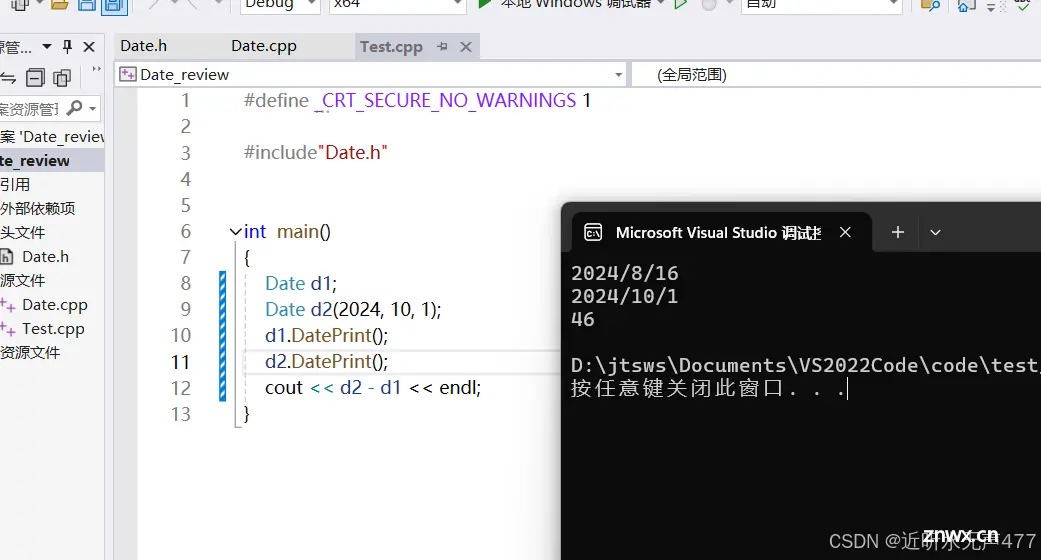
我们就简单测试一下从 8 月16号,到今年国庆节之间的天数差,然后我们就在网上的日期计算器上验算一下我们得结果:
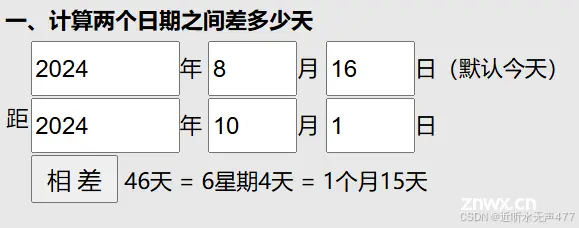
8.代码展示
我们完成了日期计算器的, 接下来是代码展示:
Date.h
<code>#pragma once
#include<iostream>
#include<assert.h>
using namespace std;
class Date
{
public:
friend ostream& operator<<(ostream& out, const Date& d);
friend istream& operator>>(istream& out, Date& d);
Date(int year = 2024, int month = 8, int day = 16);
///~Date();
//日期值的打印
void DatePrint();
//赋值运算符的重载
Date& operator=(const Date& d1);
//比较大小运算符的重载
bool operator==(Date& d);
bool operator!=(Date& d);
bool operator>(Date& d);
bool operator<(Date& d);
bool operator<=(Date& d);
bool operator>=(Date& d);
//获取每个月的天数
int GetMonthDay(int year, int month)
{
assert(month >= 1 && month <= 12);
//因为这个数组会高频·的进行调用,所以使用静态数组就能极大地提高效率
static int MonthDay[13] = { -1, 31,28, 31 ,30, 31,30, 31, 31, 30, 31, 30, 31 };
//借用短路效应,适当的提高效率
if ( month == 2 && (year % 4 == 0 && year % 100 != 0) || year % 400 == 0)
{
return 29;
}
return MonthDay[month];
}
Date& operator+=(int day);
Date operator+(int day);
Date& operator-=(int day);
Date operator-(int day);
//前置++
Date& operator++();
Date& operator++(int );
Date& operator--();
Date& operator--(int);
//计算两个日期之间的天数差
int operator-(const Date& d);
bool CheckDate()
{
if (_month >= 13 || _month <= 0)
{
return false;
}
if (_day >= GetMonthDay(_year, _month)|| _day <= 0)
{
return false;
}
return true;
}
private:
int _year;
int _month;
int _day;
};
//ostream& operator<<(ostream& out, const Date& d);
//& operator>>(istream& out, const Date& d);
Date.cpp
#define _CRT_SECURE_NO_WARNINGS 1
#include"Date.h"
Date::Date(int year, int month, int day)
{
_year = year;
_month = month;
_day = day;
if (!CheckDate())
{
cout << "输入非法日期!!" << "->";
cout << *this;
}
}
void Date::DatePrint()
{
cout << _year << "/" << _month << "/" << _day << endl;
}
bool Date::operator==(Date& d)
{
return _year == d._day
&& _month == d._month
&& _day == d._day;
}
Date& Date::operator=(const Date& d1)
{
_year = d1._year;
_month = d1._month;
_day = d1._day;
return *this;
}
bool Date::operator!=(Date& d)
{
return !(*this == d);
}
bool Date::operator>(Date& d)
{
if (_year > d._year )
{
return true;
}
else if (_year == d._year && _month >d._month)
{
return true;
}
else if (_year == d._year && _month == d._month && _day > d._day)
{
return true;
}
return false;
}
bool Date::operator<(Date& d)
{
return !(*this >= d);
}
bool Date::operator<=(Date& d)
{
return *this < d || *this == d;
}
bool Date::operator>=(Date& d)
{
return *this > d || *this == d;
}
Date& Date::operator+=(int day)
{
if (day < 0)
{
return (*this -= -day);
}
_day += day;
while (_day > GetMonthDay(_year, _month))
{
_day -= GetMonthDay(_year, _month);
_month++;
if (_month >= 13)
{
_year++;
_month = 1;
}
}
return *this;
}
Date Date::operator+(int day)
{
Date tmp = *this;
tmp += day;
return tmp;
}
Date& Date::operator-=(int day)
{
if (day < 0)
{
return (*this += -day);
}
_day -= day;
while (_day <= 0)
{
_day += GetMonthDay(_year, _month);
_month--;
while (_month <= 0)
{
_year--;
_month = 12;
}
}
return *this;
}
Date Date::operator-(int day)
{
Date tmp = *this;
tmp -= day;
return tmp;
}
Date& Date::operator++()
{
return (*this += 1);
}
Date& Date::operator++(int)
{
Date tmp(*this);
*this += 1;
return tmp;
}
Date& Date:: operator--()
{
return (*this -= 1);
}
Date& Date::operator--(int)
{
Date tmp(*this);
*this -= 1;
return tmp;
}
int Date::operator-(const Date& d)
{
Date small =d ;
Date big = *this;
int flag = 1;
if (big < small)
{
big = d;
small = *this;
flag *= -1;
}
int count = 0;
while (small < big)
{
small++;
++count;
}
return (count - 1) * flag;
}
ostream& operator<<(ostream& out, const Date& d)
{
out << d._year << "年" << d._month << "月" << d._day << "日" << endl;
return out;
}
istream& operator>>(istream& in, Date& d)
{
cout << "请依次输入有效的年月日信息" << endl;
while (1)
{
in >> d._year >> d._month >> d._day;
if (d.CheckDate())
{
break;
}
cout << "日期非法!!" << "->";
cout << d;
}
return in;
}
Test.c
#define _CRT_SECURE_NO_WARNINGS 1
#include"Date.h"
int main()
{
Date d1;
Date d2(2024, 10, 1);
d1.DatePrint();
d2.DatePrint();
cout << d2 - d1 << endl;
}
好,今天的学习就到这里了,我们下期再见,拜拜!!!
声明
本文内容仅代表作者观点,或转载于其他网站,本站不以此文作为商业用途
如有涉及侵权,请联系本站进行删除
转载本站原创文章,请注明来源及作者。